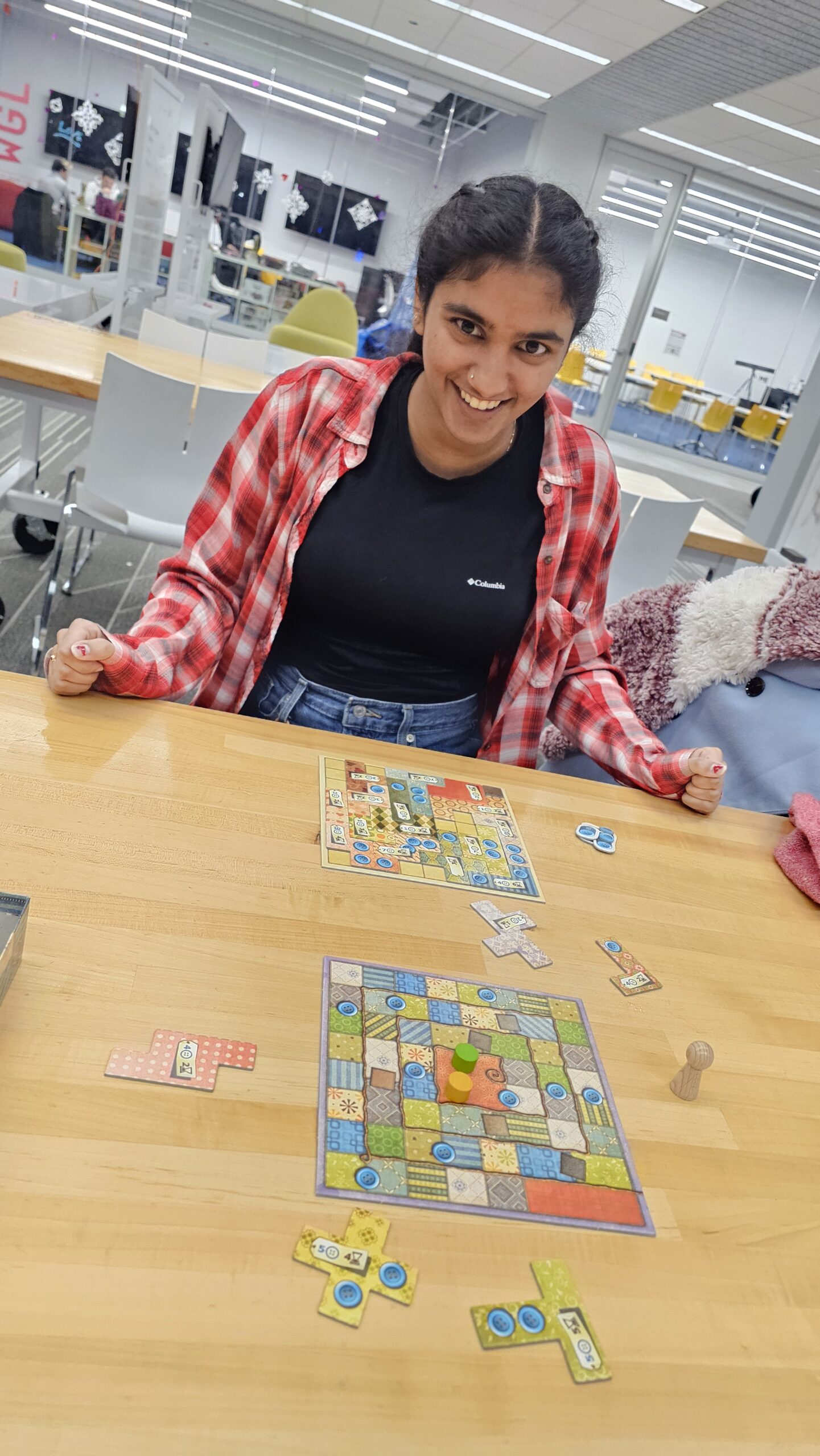Patchwork is a board game for two players that involves placing differently shaped patches onto a quilt board and acquiring buttons before time runs out. The goal is to have your quilt board as filled with patches as possible and to have as many buttons as possible at the end of the game. The mechanics include moving a token through a time board, acquiring and spending buttons, and buying and placing patches onto a quilt board. The game is themed around quilt-making from scrap fabric patches. I played Patchwork with my roommate, and I was surprised at how my strategy to fill my quilt board and acquire buttons changed over the course of the game. I was also surprised at how much my roommate and I collaborated to help each other fill our boards despite playing against each other.
To begin, the players spread out all the patches in a circle and place a marker at some point on the circle. Each player receives an empty quilt board, and each player places a token at the beginning of the spiral-shaped time board that sits in the middle of the patch circle. As players take turns, they move the tokens through the spiral time board to acquire either buttons or patches. The patches are different shapes and sizes, and they are available for different costs of buttons and time spaces. Some patches have buttons printed on them, which allow the player to receive more buttons later in the game. The patches available to buy are the three patches clockwise to the marker placed in the circle of patches. When a patch is bought, the marker is moved to the place in the circle where that patch used to sit. I appreciated this detail because it meant I couldn’t just choose to buy whichever patches would best fill my quilt board. It also allowed me to buy a patch to move the marker past a patch that would have given my roommate an edge. The game ends when both tokens are at the center of the spiral time board. Each player’s score is the number of buttons they have subtract twice the number of empty squares on their quilt. The player with the highest score at the end of the game wins.
Throughout the spiral time board, there are points where the first player to reach the point can receive a special 1×1 tile to fill a hole in their quilt. There are also points where players can receive a number of buttons determined by the buttons included in the patches on their quilt. I enjoyed having these points of interest in the time board because it allowed me to strategize how many time spaces I wanted to move my token each turn. When I was close to a point where I could receive a special 1×1 square, I chose to buy patches that came with a high time cost so that I could reach the 1×1 square before the other player. Because I received many of the 1×1 squares, my quilt had less holes in it than my roommate’s quilt. When I was about to pass through a point where I would receive buttons based on the patches in my quilt, I bought patches that had a lot of buttons on them because I wanted to make the most of the button collection points.
I was surprised by how my strategy changed from the beginning to the end of the game. At the beginning of the game, I was mostly concerned with buying a lot of patches, especially those with buttons on them. I was not worried about the shape of the patches or where I placed them on my quilt board because I had so much space on the board. I wanted to buy a lot of patches because there were a lot of button collection points ahead of me, and I wanted to make the most of them. Towards the end of the game, I was more concerned with the size and shape of the patches than acquiring more buttons. I had amassed a button farm from the patches I bought in the early game, and now I could spend them on exactly the patches I wanted to best fill in my quilt. It didn’t matter as much whether they had additional buttons on them anymore. I think that additional planning in the early game about patch placement would be beneficial for the late game.
I was also surprised by how much I wanted to help my roommate when I saw a patch that would fit nicely into her quilt board despite playing against her. I wanted to help her because it was more satisfying to fit an oddly shaped patch into an awkward hole in the quilt than it was to technically win the game. Fitting patches together was like solving a puzzle, and I didn’t want to leave a puzzle unsolved just so I could have less empty squares at the end than my roommate. I wanted to leave as few empty squares on both boards as possible. I did enjoy beating her at the competitive parts like reaching the 1×1 squares before she did. Because of the puzzle and competitive aspects, Patchwork can be both a collaborative puzzle and a competitive board game, which I didn’t realize until I played it with my roommate.
-Sara Hoggatt
